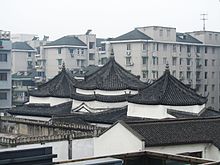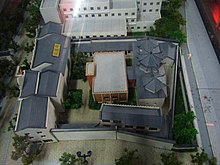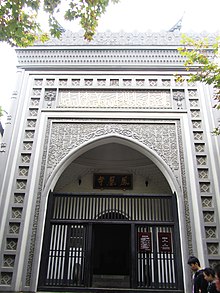Phoenix Mosque
 From Wikipedia the free encyclopedia
From Wikipedia the free encyclopedia
| Phoenix Mosque | |
|---|---|
凤凰寺 | |
 | |
| Religion | |
| Affiliation | Islam |
| Branch/tradition | Sunni |
| Location | |
| Location | Hangzhou, Zhejiang, China |
| Geographic coordinates | 30°14′52″N 120°9′56″E / 30.24778°N 120.16556°E |
| Architecture | |
| Type | mosque |
| Style | Chinese |


Phoenix Mosque (simplified Chinese: 凤凰寺; traditional Chinese: 鳳凰寺; pinyin: Fènghuáng Sì) is a mosque in Hangzhou, Zhejiang, China. It is known for being one of the four great mosques of China. It is also one of the earliest mosque built in China. The origin of this mosque dates back to the Tang or Song dynasty.
The Phoenix Mosque had been rebuilt several times. It was first destroyed around the end of Song dynasty. During the following Yuan dynasty, in 1281, the mosque was repaired under the financial assistance of Ala al-Din, a Persian settler in China.[1][2] The minaret of the mosque was removed in 1928 due to the construction of adjacent roads. In 1953, the mosque underwent a complete maintenance and repair project.[3]
The structure of the main building was heavily influenced by traditional Chinese Architecture while also retaining features of Islamic Architecture. The existing prayer hall was built in the year of 1281 during the rule of Kublai Khan.[4][5]
Muslim community in Hangzhou
[edit]China's southeast coastal region was an important site for exchange between Chinese and Arabic communities through the maritime Silk Road. Particularly, this provided an opportunity for Muslim communities to be established in port cities like Hangzhou.[6] This cultural exchange was only heightened when Hangzhou became the capital of the Song dynasty during its last century.[7] During the Song dynasty, a majority of the Muslim immigrants in Hangzhou came from an Arabic-Islamic cultural background due to the trade relations between the Arab world and Song government. Despite the steady growth of the Muslim community in the region, their influence on local society was still minimal.[8]
After the fall of the Song dynasty, the new Mongol rulers of the Yuan dynasty continually welcomed Muslim traders and people into the region.[5]During this period, Hangzhou became a flourishing cosmopolitan city with an influential and active Muslim community. Muslims in Hangzhou had their own settlements, burial grounds, and a few Friday mosques.[8] Travelers like Marco Polo and Ibn Battuta, described Hangzhou as being large and vibrant.[9] In fact, Italian missionary Odoric of Pordenone even wrote that Hangzhou was "the City of Heaven" and noted that he met some people in Venice who had also visited Hangzhou.[8] While a large portion of the Muslim community in Hangzhou were Arab and Persian Muslims, there were also diasporic Muslims from Annam, India, and Korea.[9] Additionally, there were also some Muslim immigrants from other regions in China as well. Later in the Ming dynasty, there was yet another influx of Chinese Muslims to Hangzhou as the region became a hotbed of the silk industry.[10] Indeed, the Muslim community was so well-rooted that during the Qianlong period in the Qing dynasty, the Qing emperor's consort, the Fragrant Concubine, visited the Phoenix Mosque whenever she passed through Hangzhou.[5]
Architecture of the mosque
[edit]The main entrance to the Phoenix Mosque is on the east side of the complex. Due to this, once a worshipper enters the complex, they immediately face the qibla containing the mihrab. Notably, it is the oldest mosque with this arrangement.[11] The qibla is located at the back of a central, octagonal domed space. There are two domes on either side of the central dome that are hexagonal in shape.
The interior of the central dome is decorated with painting depicting flowers, mountains, animals, and rivers. These paintings are contained with a symmetrical floral motif. These well-preserved decorations date back to the Ming dynasty. The two surrounding domes have a similar design as well.[1] The zone of transition between the dome and the prayer hall is decorated with honeycomb and tiered plaster surfaces. The prayer hall itself is made of brick and is the oldest remaining part of the building.[12] This is reminiscent of the muqarnas, a structural motif common in Islamic mosque architecture.[11] However, this mosque also features corner bracketing characteristic of Chinese temples. The row of three domes described previously is also a feature of Chinese architecture. Thus, this mosque demonstrates a blend of Chinese and Islamic architectural styles.
The mosque features an I-shaped floor plan, which is named the gong-plan for the Chinese character "工."[13] This configuration is characterized by two large halls joined by narrow arcade. In Chinese architecture, this plan is usually reserved for important buildings. For instance, some of the halls in the Forbidden City in Beijing have this plan as well.[13] Additionally, the floor plan of this mosque is said to also resembles its namesake "phoenix," as the main worship hall spreads out beyond the center of the mosque like the wings of a phoenix.[11] The first written association of this mosque with the phoenix is found on a 15th-century stele written by Liu Zhiping, but it is possible that the name predates the inscription.[11]
The steles and tombstones
[edit]Much of the historical record of this mosque is recorded on a collection of steles that are now housed within the mosque complex. They corroborate information about the historical location of the mosque and also describe other nearby centers of worship such as a Uighur mosque and a Nestorian church.[1] These steles also show that the mosque has had many historical names before its current name. Some historical names include the Temple of Ritual Salutations, Wu-lin Gardens, and Li Bai Temple. Other steles in the mosque complex corroborate evidence that the mosque was built in the Tang dynasty but destroyed by fire at the end of the Song.[1]
In addition to the steles, the mosque currently houses twenty-one Yuan dynasty tombstones which were retrieved from a Muslim cemetery. These tombstones are written in stylized Arabic and Persian and detail the deaths of some military and religious figures, as well as merchants. Some of the tombstones include dates given in not only the Islamic calendar, but the Turkish animal calendar and Chinese calendar as well. This shows the multicultural and cosmopolitan characteristic of Mongol rule in the area.[1] The style of the inscriptions also shows the rich Muslim community of the area during this period in time. Three of the elegies on the tombstones were composed specifically for the memorialized person. Hangzhou not only hosted skilled engravers to inscribe the works, but also poets to write compositions for these steles.[1]
The mosque currently
[edit]Today's Phoenix Mosque is around half the size that it was in the Song or Yuan dynasty. While it used to be one of the six mosques servicing the Muslim community in Hangzhou, it is now the only remaining mosque.[13] Currently, Friday prayers and festivals are not prayed, and the prayer has moved to the new Hangzhou Mosque.
Repair and renovation history
[edit]The Phoenix Mosque has been destroyed, renovated, and repaired several times. Its current form is an amalgamation of changes made during these periods of reconstruction.
1451 renovation
[edit]
Notably, this restoration contributed the current mihrab of the Phoenix mosque. It is made from gilded red wood and has inscribed verses from the Qur'an.[1]
1743 renovation
[edit]This restoration was presided over by a local Muslim scholar called Scholar Ding. An inscription detailing this project lists 233 donors, including from many regions outside of Hangzhou. The longest distance donation is one from Cangzhou, which today is in the Hui Autonomous Region near Beijing. This record shows that long distance donors and diasporic donor networks contributed to the survival of large mosques like the Phoenix Mosque in regions where the Muslim population was the minority.[14]
The opening lines of the inscription detailing this renovation evokes an edict passed by the first Ming emperor, Hongwu Emperor. In this edict, the Emperor commissions two mosques in Xi'an and Nanjing. At the time, the 1743 inscription was written, it had been nearly 400 years since the issuing of the Emperor's edict. Unlike Buddhism and Daoism, Islam was less institutionalized by the imperial government. This inscription shows that aspiration of the Muslim community to be institutionally recognized in the same way as other faiths.[14]
Other renovations
[edit]The mosque used to have a minaret that was destroyed in 1929 and replaced by a gate. The current gate with two minaret-like towers was constructed in 1953.[11]
References
[edit]- ^ a b c d e f g The Mongols' Middle East : continuity and transformation in Ilkhanid Iran. Bruno De Nicola, C. P. Melville. Leiden. 2016. ISBN 978-90-04-31472-6. OCLC 945693873.
{{cite book}}: CS1 maint: location missing publisher (link) CS1 maint: others (link) - ^ Lane, George (2018). The Phoenix Mosque and the Persians of Medieval Hangzhou. University of Chicago Press.
- ^ "凤凰寺". 浙江在线. Archived from the original on 2016-03-04. Retrieved 2013-12-31.
- ^ "杭州凤凰寺". 浙江省文物局. Archived from the original on 2014-01-01. Retrieved 2013-12-31.
- ^ a b c Lane, George A. (2019). The Phoenix Mosque and the Persians of Medieval Hangzhou. Gingko Library. ISBN 978-1-909942-89-9.
- ^ Lei, Wan (2017). The earliest Muslim communities in China. Riyadh. ISBN 978-603-8206-39-3.
- ^ Ma, Jianchun (2011). "Muslim Fan and Hu businessmen Dwelling in Hangzhou during the Song Dynasty". China Academic Journal Electronic Publishing House – via CNKI.
- ^ a b c 马, 娟 (2018). "元代杭州的穆斯林移民" (PDF). 民族研究. 1.
- ^ a b Chaffee, John (2006). ""Diasporic Identities in the Historical Development of the Maritime Muslim Communities of Song-yuan China"". Journal of the Economic and Social History of the Orient. 49 (4): 395–420. doi:10.1163/156852006779048408. ISSN 0022-4995.
- ^ Zvi, Ben-Dor Benite (2005). The dao of Muhammad : a cultural history of Muslims in late imperial China. Published by the Harvard University Asia Center. ISBN 0-674-01774-9. OCLC 474878214.
- ^ a b c d e Steinhardt, Nancy Shatzman (2019). China's early mosques. ISBN 978-1-4744-7285-2. OCLC 1145341149.
- ^ Chang, Jing Qi. 1982. “Islamic Architecture in China”. In The Changing Rural Habitat; Volume 2: Background Papers, edited by Brian Brace Taylor. Singapore: Concept Media/Aga Khan Award for Architecture, 1982.
- ^ a b c Steinhardt, Nancy Shatzman (2008-09-01). "China's Earliest Mosques". Journal of the Society of Architectural Historians. 67 (3): 330–361. doi:10.1525/jsah.2008.67.3.330. ISSN 0037-9808.
- ^ a b Brown, Tristan G. (2013-06-01). "Muslim Networks, Religious Economy, and Community Survival: The Financial Upkeep of Mosques in Late Imperial China". Journal of Muslim Minority Affairs. 33 (2): 241–266. doi:10.1080/13602004.2013.810118. ISSN 1360-2004. S2CID 144114084.
